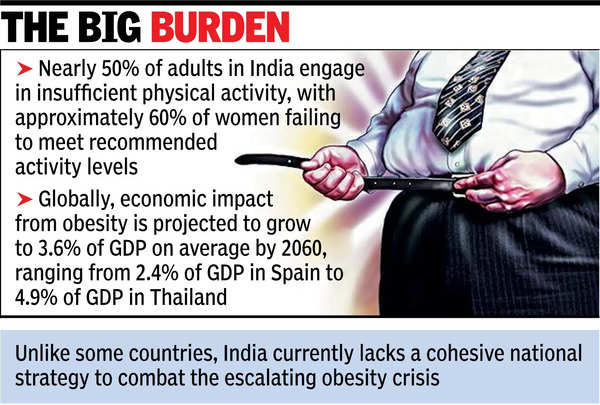India’s obesity burden to swell to Rs 6.7L cr/year by 2030: Study | Hyderabad News

HYDERABAD: Fat isn’t just fit for you, it’s flab for the economy, too. PM Modi’s resolve to address India’s rising obesity rate – he flagged it in the Mann Ki Baat episode last Sunday – is backed by data that also shows the far-reaching economic consequences of what many see as just a public health problem.
According to online forum Global Obesity Observatory, the economic impact of obesity in India in 2019 was estimated to be $28.95 billion (Rs 2.4 lakh crore), equivalent to around Rs 1,800 per capita and 1.02% of GDP.

By 2030, that is projected to grow to $81.53 billion (Rs 6.7 lakh crore, based on current exchange rate). This would work out to Rs 4,700 per capita, or 1.57% of GDP. In another 30 years, unchecked obesity could see the figure burgeon to $838.6 billion (Rs 69.6 lakh crore). This will mark a per capita drain of Rs 44,200, which is 2.5% of GDP, says the report.
The National Family Health Survey-5 pegged overall weighted prevalence of overweight and obesity in men and women at 44% and 41%, respectively, compared to 37.7% and 36% in the previous cycle.
“The economic impact of obesity could become unsustainable, putting immense pressure on both the public health system and the economy,” a healthcare expert said.
Avula Lakshmaiah, a retired scientist of National Institute of Nutrition, said the broader economic impact could be much higher than calculated. “The repercussions of obesity extend beyond treatment costs – loss of livelihood, opportunity costs, and emotional toll due to lack of societal support also contribute significantly to this economic burden,” he told TOI.
Global Obesity Observatory has developed a comprehensive checklist of policy measures designed for countries worldwide to reduce and monitor obesity rates.
While India’s checklist reflects several positive initiatives, the country currently lacks a cohesive and unified national strategy to combat escalating obesity crisis, particularly among kids. India has a national nutrition strategy focused on ensuring that all children, adolescent girls, and women achieve optimal nutritional status, especially those hailing from the most vulnerable communities.
‘Schools, workplaces must promote physical activity’
Physical inactivity is a major contributor to the obesity crisis. Global Obesity Observatory’s 2022 data reveals that nearly 50% of adults in India engage in insufficient physical activity. The situation is particularly alarming among women, with approximately 60% failing to meet recommended activity levels.
Schools, workplaces, and communities must promote physical activity as an essential part of daily life, an expert said. Krishna Reddy Chittedi, an associate professor at the School of Economics, University of Hyderabad, proposes a “fat tax” on junk food, drawing inspiration from Kerala’s successful implementation of this policy in 2016. “Obesity is costing India nearly 2% of its GDP. While we have policies addressing malnutrition, we need to equally focus on combating obesity,” he told TOI.
















